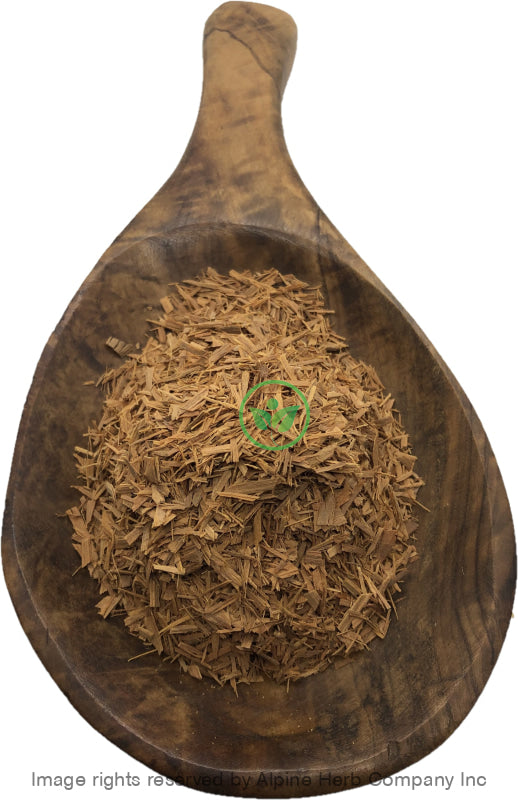Cat’s Claw Bark Cut Alpine Herb Company Inc.
$ 13,99 $ 8,39
Botanical Name: Uncaria tomentosa
Common Name:
- English: Cat’s claw
- Also, known as: uña de gato, paraguayo, garabato, garbato casha, samento, toroñ, tambor huasca, uña huasca, uña de gavilan, hawk’s claw, saventaro, Vilcacora
Origin: Peru
Harvested: Cultivated
Parts Used: Tree bark
General Information:
Cat’s claw (U. tomentosa) is a large, woody vine that derives its name from hook-like thorns that grow along the vine and resemble the claws of a cat. Two closely related species of Uncaria are used almost interchangeably in the rainforests: U. tomentosa and U. guianensis. Both species can reach over 30 m high into the canopy. U. tomentosa has small, yellowish-white flowers, whereas U. guianensis has reddish-orange flowers and thorns that are more curved. Cat’s claw is indigenous to the Amazon rainforest and other tropical areas of South and Central America. Cat’s Claw Bark has been used in Peru & Europe since the last 2000 years and Indian tribe in central Peru has the longest recorded history of use of the plant. They are also the largest commercial source of Cat’s claw from Peru today. There are other species of plants with a common name of cat’s claw (or uña de gato) in Mexico and Latin America; however, they are entirely different plants. Several of the Mexican uña de gato (Cat’s Claw) varieties have toxic properties.
How to use:
Decoctions are suitable for roots, barks, large seeds & berries, and other dense material. The simple way to make decoction is, in a saucepan, add 1 tablespoon of dried herbs to 1 cup of water. Bring the water to boil, reduce heat and simmer for 30-60 minutes. Strain and squeeze out as much as liquid as possible and enjoy!
Tips:
- You can sweeten your herbal decoctions with bit of honey, natural fruit juice, stevia leaves powder and or licorice root powder.
Precautions:
You should consult with a qualified healthcare practitioner before using any herbal products, particularly if you are pregnant, nursing, or on any medications.
All information on this website is for educational purpose ONLY
This information has not been evaluated by Health Canada.
This information is not intended to diagnose, treat, cure, or prevent any disease.
| Unit Size | 100g, 200g, 400g, 1kg |
|---|
Prompt shipping and expert packing
Thanks to our longstanding association with UPS FedEx DHL as well as other leading global carriers, we can offer a variety shipping options. Our warehouse staff is highly trained and will be able to pack your goods in accordance with our precise and exact specifications. Your items will go through an exhaustive examination before they will be securely packaged before being delivered. We ship to hundreds of thousands of customers daily in different countries. This is a sign of our determination to become the largest online retailer worldwide. Warehouses and distribution centers are located throughout Europe as well as in the USA.
Note that orders containing multiple items are processed according to the particular item.
We will thoroughly inspect all items ordered before shipping. Most orders are shipped within 48 hours. The delivery time will be between 3 and 7 working days.
Returns
The stock market is always changing. It's not entirely managed by us since we're involved with several entities, including the factory and the storage. Therefore, the actual inventory could fluctuate at any moment. Please be aware that it is possible that your order could be out of stock after you've placed your order.
Our policy lasts for 30 days. If it's been more than 30 days since the date you purchased your item We're sorry to say that we can't offer you a full exchange or refund.
You can only return a product if it is unused and still in the same state as when you received it. The item should be in the original packaging.


































